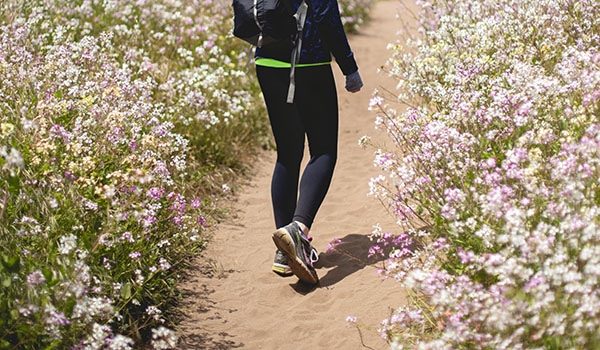Sneak peek at our top 5 tips:
- Try walking shoes on at the end of the day.
- Look for good Achilles, heel and sole support.
- Don’t delay replacing your walking shoes.
- Choose walking shoes with waterproofing.
- Only use your walking shoes for walking.
Walking shoes are one of those things you don’t know you need until you have them. However, buying a pair isn’t as simple as strolling into a store, finding a pair that fit and walking out. There are rules, people!
Well, maybe not rules but there certainly are ways you can make the process a whole lot easier. It just so happens you can find these tips in this article to finding functionable, but comfortable, walking shoes.
Oh, and if you’ve just looked down at your feet and realised they need a little love before going shopping, we’ve got your back there too. Try this indulgent foot spa at home!
5 Top Tips for Choosing Comfortable Walking Shoes
1. You should always try on walking shoes at the end of the day.
It’s recommended you leave a little wiggle room (roughly 1.3cm between your toe and the end of the shoe) in your walking shoes. However, during the day, our feet tend to swell. This means if you’ve fitted your shoes for your ‘morning feet’, you’ll not have any wiggle room for the afternoon.
Why should you leave space in between your toe and shoe? Well, shoes that are too tight can cause pain from swelling, black toenails and blisters, as well as being uncomfortable to boot.
You should also try on both shoes as one of our feet tend to be bigger than the other. Oh, and be sure to bring along the socks you’d normally wear with walking shoes, so you know exactly what they’ll feel like together.
Tip: You should also try on rings later in the day as our fingers swell too.
2. Look for walking shoes with good Achilles, heel and sole support.
Wearing the wrong type of shoes for walking can cause stress and pain to our bones and joints, as well as aggravate existing issues, like arthritis. You’ll want to look for a lightweight walking shoe known for having good shock absorption, which will help reduce heel pain.
It’s worth also trying on a walking shoe with a rounded bottom, as some people find them easier to keep good posture.
3. Replace your walking shoes when the outsole is worn.
How often should you replace your walking shoes? If you walk an average of 45 minutes a day, at least three times a week, expect to need to replace walking shoes every three to five months. It will depend on the quality and style of the shoe, as well as your walking gait and the terrain walked on.
Keep an eye on your outsoles (bottom of your shoe that contacts the ground) and ensure they’re in good condition. Once they’re looking a little worse for wear or you notice you’re not getting enough support, it’s time for a replacement pair.
4. Look for a waterproofed walking shoes or purchase a protection treatment.
Unless you’ll only ever be wearing your shoes indoors (such as for a job involving a lot of walking), you’ll eventually come across water. Rain, puddles, even excessively dewy grass, can all impact the condition of your shoes and comfort.
Ensure the walking shoes you choose are either waterproof or that you purchase a protector spray to treat them with once you are home. This will help keep your shoes in better condition for longer and can even protect them against stains.
5. Only look for walking shoes if that’s what they’ll be used for.
If you’re about to wear your walking shoes hiking, long-distance running or weightlifting, you may want to think again. Every type of shoe is made for a purpose. A hiking boot will have thicker soles that can’t be penetrated by rocks, sticks and any other loose debris. While a power lifting shoe will tend to have more achilles support and a flat, sturdy base.
On the other hand, walking shoes have quite flexible soles and are quite light. If you were to wear them hiking, you’d probably cop a stick or two through your shoe, as well as some almighty blisters.

One of the best things you can do is go and see a podiatrist.
A podiatrist specialises in feet, amongst other things. This includes helping treat any foot conditions you may have, impacting your walking gait and comfort. They will also be able to recommend the right walking shoes for your foot shape, walking style and the purpose of the shoe.
You can find a podiatrist near you on Localsearch! Use the search bar to find your locally recommended podiatrist.
Feature image source: Markus Spiske from Pixabay






